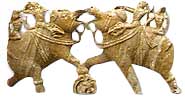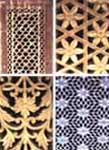|
|
|

|
 |
The
geologically old land of Rajasthan is rich in different
kinds of hard rocks, yielding granites, marbles, quartzites,
slates, and other metamorphic rocks. With the ready availability
of high-quality stone (the use of brick was almost unknown),
it was easy for the Rajasthani builder to construct strong
and beautiful forts, palaces, and temples. The full extent
of the Rajasthani stone-cutters' skill can be seen in the
richness and beauty of the large number of sculptures found
in the temples built ancient and medieval times in Bharatpur,
Abaneri, Baroli, Ramgarh, Nagda, Ajmer, Chittor, Mandore,
Osiytan, Jaisalmer, Bikaner, and Udaipur.
|
Stones for buildings-
While Makrana produces white marble, Rupbas(near Agra) and
Karauli produce red sandstone used by the Mughals to build
their forts and palaces at Agra, Delhi, and Fatehpur Sikri;
Kota in east Rajasthan produces gray stone for floor making;
Barmer produces yellow marble for delicate carvings; and Ajmer
produces granites.
|
|
Stone Carving- The silavat
(stone carver) carefully selects the stone, draws the design
in charcoal and chips away the unwanted stone to create superbly
reliefed jali works used to adorn temples, palaces, and forts. |
Female
Dancer- This intricately carved
sculpture is from Karni Mata Temple in Deshnoke, Bikaner. Though
it does not have the free-standing or high-relief sculptural decorations
found in the earlier temples of Abaneri, Baroli, Ramgarh, or Mandore,
its delicate embellishments are no less striking. Stylized birds,
flying, craning necks, or perching, from the border of this niche,
with a female dancer hidden behind large leaves carved with immense
care.
 |
Dedicated
to Gods- A row of figures
embellishes the Surya temple, Jhalarapatan, in southern
Rajasthan. The stone carvers of this region, like their
counterparts in north Gujarat and western Madhya Pradesh,
produced some of the finest temples dedicated to Devi, Shiva,
Vishnu, and the Sun God, adorning the buildings with many
delicately carved figures of human and celestial beings.
|
|
The Genius of Jali- The
genius of the Rajasthani silavat is seen in architectural
pieces such as pillars, lintels, jalis( latticed grilles),
and friezes. Some of the finest examples of jali work reign
at Jaisalmer in unique mansions such as Patwon-ki-haveli,
Nathmalji-ki-haveli, and Salim Singh-ki-haveli, where the
stone carver has effectively transformed
the hard surface of the yellow sandstone into soft, transparent
traceries.
|
|
Stone Masonry-
Even as late as in the 19th and early 20th century the 0stone
masons of Jaipur, Udaipur, Bikaner, Jodhpur, and Kota were capable
of recreating the fine detail of earlier works, as can be seen
in the delicate jali and relief works of the palaces and monuments.
Mubarak Mahal in Jaipur's City Palace and the imposing gateway
of City Palace, flanked by two monolithic white elephants(right),
provide typical examples from this period.
 |
Elephants
in High Relief- This pair
of elephants forms part of a sculptured panel from a Jain
temple, Sat Bis Deorhi, in Chittorgarh. Hindu and Jain temples,
Victory towers, and the palace coexist within the sprawling
fort of Chittorgarh.
|
Various
panels within the temple display figures of men, women, and animals
in high relief. The majestic figures of elephants abound everywhere.
|
|




